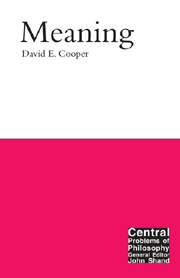6 - Meaning and the Arts
Summary
“But what does it mean?” Who has not heard, or indeed raised, that question on such occasions as standing before an unmade bed in an art gallery, or listening to a piece called “Invention VI for Oboe and Synthesizer”? The vocabulary of meaning is pervasive in contemporary discussion of art, and not only of the literary arts that inherit familiar issues of linguistic meaning and generate several more of their own, like that of authorial authority over the meaning of a text. Few books on the philosophy of music, for example, are without their chapter on meaning in music.
There's no doubt that the broad issue which has dominated is that of the kind(s) of meaning possessed by artworks, and the bulk of this chapter will be duly devoted to that. But it is not the only one. Possession is not the sole relation that an artwork can bear to meaning. Questions may be asked as well about meanings as, so to speak, the subject-matter of art – as what art may reveal or communicate about. This will be the topic for the first section. The two topics are not unrelated, for those who think that art is uniquely equipped to reveal dimensions of meaning are apt to see, in that revelation, an important dimension of art's own significance. The meaning of certain artworks may show up, as it were, through their showing up the meanings of whatever they are “about”.
- Type
- Chapter
- Information
- Meaning , pp. 107 - 125Publisher: Acumen PublishingPrint publication year: 2003



